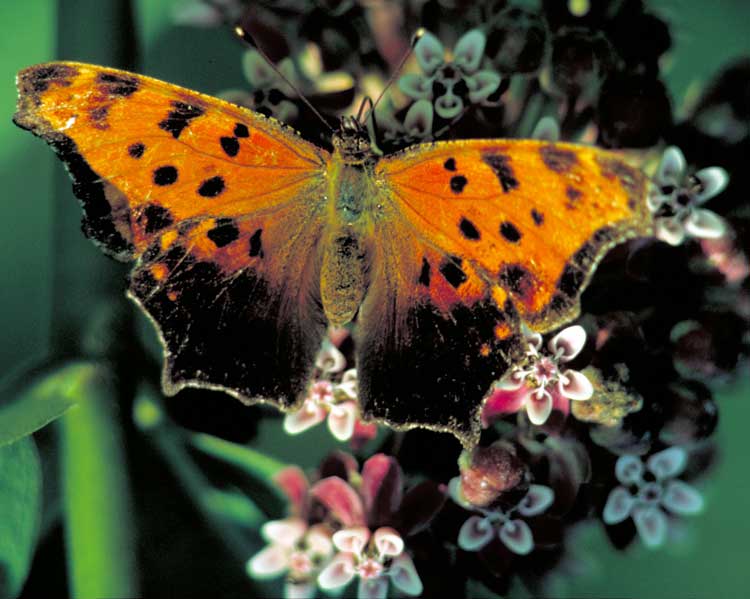
Polygonia comma, Photo: U.S. Fish and Wildlife Service
Superregnum: Eukaryota
Cladus: Unikonta
Cladus: Opisthokonta
Cladus: Holozoa
Regnum: Animalia
Subregnum: Eumetazoa
Cladus: Bilateria
Cladus: Nephrozoa
Cladus: Protostomia
Cladus: Ecdysozoa
Cladus: Panarthropoda
Phylum: Arthropoda
Subphylum: Hexapoda
Classis: Insecta
Cladus: Dicondylia
Subclassis: Pterygota
Cladus: Metapterygota
Infraclassis: Neoptera
Cladus: Eumetabola
Cladus: Endopterygota
Superordo: Panorpida
Cladus: Amphiesmenoptera
Ordo: Lepidoptera
Subordo: Glossata
Cladus: Coelolepida
Cladus: Myoglossata
Cladus: Neolepidoptera
Infraordo: Heteroneura
Cladus: Eulepidoptera
Cladus: Ditrysia
Cladus: Apoditrysia
Cladus: Obtectomera
Superfamilia: Papilionoidea
Familia: Nymphalidae
Subfamilia: Nymphalinae
Tribus: Nymphalini
Genus: Polygonia
Species: Polygonia comma
Polygonia comma, the eastern comma, is a North American butterfly in the family Nymphalidae, subfamily Nymphalinae.
Description
Upperside of wings
This butterfly is seasonally variable. The upperside of the summer form's hindwings are all black, whereas the winter forms hindwings are reddish orange. The underside of both forms is striped with dark and light brown. There is a silvery comma mark in the middle of the hindwing in both forms. Its wingspan is 4.5–6.4 cm (1.8–2.5 in).
Habitat
The eastern comma may be spotted in woods near rivers, ponds, marshes, swamps, and other water sources.
Nectar plants
This butterfly seldom visits flowers, but rather feeds on sap, rotting fruit, salts and minerals from puddling, and dung.
Host plants
False nettle (Boehmeria cylindrica), hops (Humulus), wood nettle (Laportea canadensis) American elm (Ulmus americana), and nettle (Urtica).
Life cycle
The green eggs are laid singly or in stacks under host plant leaves and stems. The spiny larva varies in color from pale green to yellow to white and to even black. The solitary larva feeds on leaves at night. Older larvae construct daytime leaf shelters by pulling a single leaf together with silk. The chrysalis is brown and covered with spines. Winter-form adults overwinter;[2] some will also migrate south for the winter.
Similar species
The dark form of comma is frequently confused with the dark form of the question mark (P. interrogationis), but the two can readily be distinguished by the shape of the comma mark on the underside. The pale form is easily confused with the satyr comma (P. satyrus), which usually occurs north and west of the eastern comma's range. They can be distinguished by the upperside color, which is orange brown in the comma and tawny yellowish brown in P. satyrus; by the underside pattern, which tends to be mottled in the comma but appears to be more longitudinally streaked in P. satyrus; and by the row of pale submarginal spots on the hindwing upperside, which tend to be separate and surrounded by dark shading in comma, but are larger and tend to run together into a pale band in P. satyrus.
References
Eastern Comma, Butterflies of Canada
"NatureServe Explorer 2.0 Polygonia comma Eastern Comma". explorer.natureserve.org. Retrieved 3 October 2020.
Scott, J. A. (1999). Hibernal diapause of North American Papilionoidea and Hesperioidea. Archived 2018-10-08 at the Wayback Machine Journal of Research on the Lepidoptera 18(3):171-200.
Retrieved from "http://en.wikipedia.org/"
All text is available under the terms of the GNU Free Documentation License

